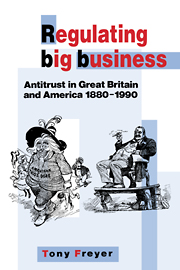Book contents
- Frontmatter
- Contents
- Preface
- Introduction
- 1 The response to big business: the formative era, 1880–1914
- 2 The divergence of economic thought
- 3 The political response
- 4 The courts respond to big business
- 5 The impact of World War I, 1914–1921
- 6 Tentative convergence, 1921–1948
- 7 A British antimonopoly policy emerges, 1940–1948
- 8 Uneven convergence since World War II
- Conclusion
- Notes
- Index
6 - Tentative convergence, 1921–1948
Published online by Cambridge University Press: 21 January 2010
- Frontmatter
- Contents
- Preface
- Introduction
- 1 The response to big business: the formative era, 1880–1914
- 2 The divergence of economic thought
- 3 The political response
- 4 The courts respond to big business
- 5 The impact of World War I, 1914–1921
- 6 Tentative convergence, 1921–1948
- 7 A British antimonopoly policy emerges, 1940–1948
- 8 Uneven convergence since World War II
- Conclusion
- Notes
- Index
Summary
By 1948, the two nations' responses to big business had undergone partial convergence. During the 1920s a merger wave occurred in which British business began to follow a path toward the greater managerial centralization American firms had pioneered at the turn of the century. Still, a lag in managerial organization persisted in which business self-regulation and trade restraints prevailed to a greater extent than was true of the United States. Cartelization increased in both nations during the Great Depression, and in Britain it was facilitated by the adoption of tariff protectionism. In America, however, the triumph of cartelization was brief. By the immediate post-war years British policymakers fashioned a coherent policy established in the Monopolies Act of 1948 which, nonetheless, like the temporary measures enacted after World War I, relied primarily upon publicity. In the United States, by contrast, public officials and the courts continued to follow an ambivalent course toward loose business arrangements and managerially centralized large firms. Thus, the differing impact of pressure groups and economic thought, which all along had encouraged different results, meant that a convergence in policy was tentative.
THE NEW PARAMETERS OF COMPARATIVE BUSINESS STRUCTURE
During the 1920s, the Great Depression, and World War II each nation's business structure partially converged. The merger wave in Britain established the basis of a corporate economy which more closely approximated that of the United States. To overcome the massive economic collapse of the 1930s both countries' public officials promoted cartelization, and World War II required even more extensive business-government collaboration. Nevertheless there were noteworthy differences.
- Type
- Chapter
- Information
- Regulating Big BusinessAntitrust in Great Britain and America, 1880–1990, pp. 196 - 232Publisher: Cambridge University PressPrint publication year: 1992
- 1
- Cited by



